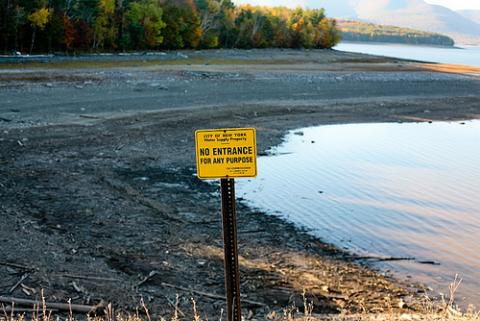
A recent action by the New York State Department of Environmental Conservation ensures that New York City's efforts to push dirty water out of the Ashokan Reservoir throughout the fall and winter are going to cost the city big time. The DEC is fining the NYC DEP $2.6 million for releasing dirty water into the Lower Esopus. The Daily Freeman reports:
The complaint, which assessed fines at the state maximum of $37,000 per day, describes six causes of action that include the use of the lower Esopus Creek to avoid sending turbid water to the Kensico Reservoir, where alum had been used as a settling agent but was found to be destroying fish breeding areas...
...The complaint notice filed by the state says the discharges into the creek occurred in an “unprecedented manner and duration ... without obtaining the (state) department’s prior approval and without providing the department with crucial information.”
The state agency said it is “illegal for any person to discharge pollutants to the waters of the state from any outlet or point source without an SPDES permit.”
SPDES, which stands for State Pollution Discharge Elimination System, is a permit required by law under the Clean Water Act in order for any act of water pollution to be done legally. The permits deal with what, in environmental jargon, is called "point source pollution" -- in other words, pollution coming from an identifiable source.
Legal definitions are funny things. Because the DEP has control over when to release water from the Ashokan, their dirty water releases are considered point-source pollution. But when the dirt, clay and other particles polluting the water enter the system in the first place -- upstream from the Ashokan, in the form of runoff from roads, streambanks, lawns and farms -- they are considered "non-point source pollution," which the Clean Water Act does not address.
According to the Times Herald-Record, when storms strike and stir up turbidity, the DEP has only two options for keeping reservoir water clean enough to be safe for 9 million New Yorkers to drink: either flush dirty water downstream and out of the system, or use alum to help settle some of the particles out. Both take a toll on the environment:
The Catskill Aqueduct system - which includes the Ashokan and Schoharie reservoirs - is prone to turbidity problems because its 514-square-mile watershed is mostly clay. When storms stir up the clay, the DEP fights that turbidity in two ways.
It either pushes dirty water down the Lower Esopus Creek, or injects into the water a chemical known as “alum” that forces dirt particles to settle on the bottom of the Kensico Reservoir in Westchester County.
New York City has been ordered to limit its use of alum because a byproduct known as “alum floc” is already polluting 16 acres of the Kensico Reservoir bed. The legal complaint filed this week also orders the city to dredge that polluted area.
Reporter Adam Bosch says the current showdown between state and city environmental regulators could end with the state being forced to choose between two unpopular options: pollute the lower Esopus, or pollute the Kensico. (At least for the next three years, until a new tunnel and filtration plant, which are expected to solve the issue, are completed.)
Photo of the Ashokan Reservoir by Flickr user Tom Giebel. Published under Creative Commons license.














